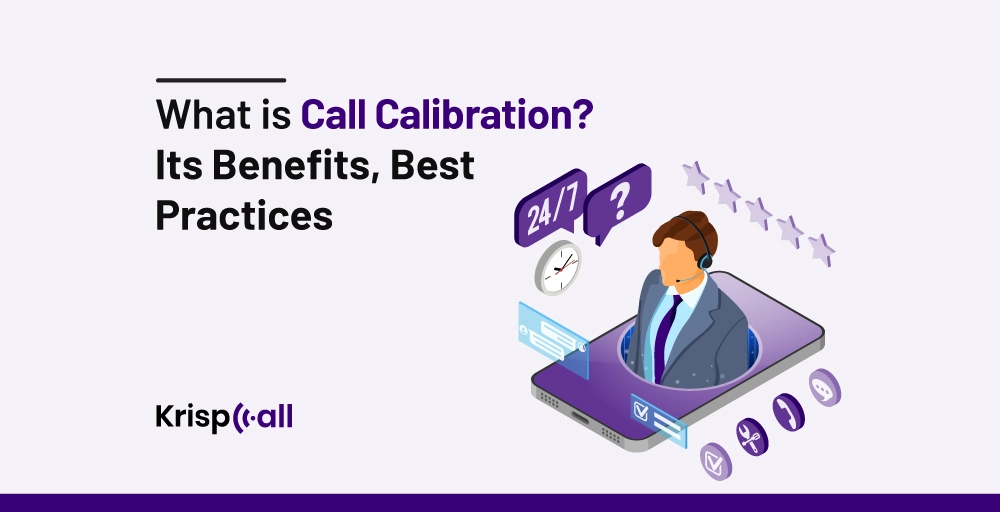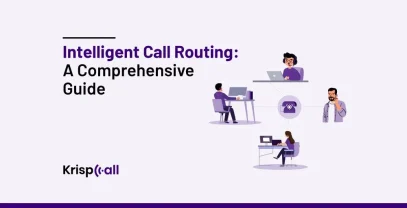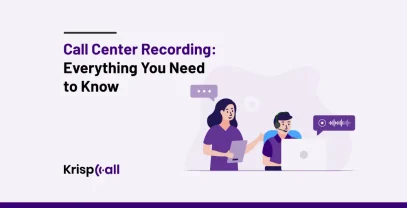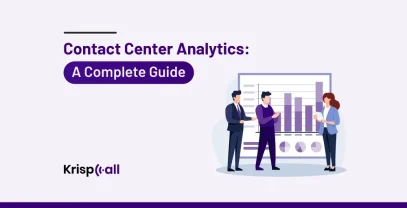Do you have a guarantee that your customers get the best experience? You don’t😬.
That is why you need a better way to determine how to grade your agent’s interaction with customers to identify customer’s experience.
Although you start grading, sometimes, it can be challenging to maintain consistency as you scale your operation and start grading for subjective topics like empathy.
There comes a solution, Call Calibration, that helps🤝you standardize the level of customer service regardless of which of your agents interact on the other end of the call.
In this guide, we will explore everything you need to know about call calibration.
🔑 Key Highlights
- A call calibration is a discussion between call center agents, supervisors, and QA evaluators to rate and review customer service calls.
- Call Calibration is vital in call centers to maintain score consistency, reach client satisfaction goals, enhance performance, identify gaps in agent’s training, and increase collaboration.
- Adapting Quality standards for documents, clean session goals, session facilitator, AI, and automation are the best practices for effective call calibration.
- Perform call calibration by creating calibration procedures, setting up a baseline, determining a facilitator, applying the agent’s self-scoring, placing the data to work, and using it regularly.
So let’s get started.
What is Call Calibration?
Call Calibration is a meeting among call center agents, supervisors, and the quality monitoring vendor to rate and review customer service calls. It is crucial to ensure managers, supervisors, and QA teams evaluate agent performance and enhance the accuracy of quality assurance (QA) measures.

It offers consistency in rating scores, minimizes QA evaluator bias, defines quality standards, and enhances coaching and training by updating all stakeholders on present standard expectations.
How does Call Calibration Work?
Call calibration works by allowing a team of evaluators, supervisors, and agents to review and asses customer service calls in terms of quality standards.
They take a specific call as a reference, assign an expert evaluator to evaluate it, and other team members provide diverse perspectives.
Participants compare their evaluations with the experts to find differences and guarantee scoring consistency. The team discusses and aligns the evaluation criteria, addresses deviations, and reaches a consensus on the final rating, seeking to minimize call variances in QA scores.
What do you mean by Call Calibration Sessions?
Call Calibration sessions are meetings where call center supervisors, QA evaluators, agents, and third-party facilitators discuss the quality of call interactions. They help consider agent performance, align standards, and improve precise quality assurance measures.
They evaluate performance based on call recording, quality standards, policies and procedures, and technology. These sessions are vital in standardizing performance evaluation, providing actionable feedback to agents, identifying training gaps, and eventually enhancing the quality of customer service communication.is
Why is Call Calibration Important in Call Centers?
Call Calibration is important in call centers due to the following reasons:
To Maintain score consistency
Call calibration plays a significant role in score consistency. It establishes a repeatable process for call quality assurance, reduces the potential for grading bias, and increases fairness and accountability. Therefore, it ensures that managers, supervisors, team leads, call center agents, or other QA evaluators score consistently using the same standards and criteria.
To Reach client satisfaction goals
Call calibration in call centers guarantees that all agents understand the quality standards they must meet when handling customer conversations. This enables call centers to consistently meet customer satisfaction goals and maintain high customer satisfaction scores.
To Enhance call center performance
Call calibration provides data and insights based on customer call evaluation and scores. It is a helpful source of information that can refine call center processes, procedures, and workflows. It identifies and handles issues that affect agent performance and communication quality, enhancing call center performance.
To Identify gaps in agents’ training
Call Calibration helps call center managers or supervisors evaluate agent performance through Average Handle Time and First-Call Resolution. They evaluate agents’ performance based on criteria such as script adherence, empathy, problem resolution, communication skills, professionalism, and adherence to transfer and escalation guidelines. Such evaluation helps managers identify gaps in agent training and ensure they are avoided in the future.
To Increase Collaboration & Engagements
Call Calibration involves managers, supervisors, QA evaluators, and call center agents, which helps to maintain transparent interaction among the call center team. When all participants are engaged in a call calibration session, collaboration and engagement eventually increase, leading to employee satisfaction and retention.
Give meaningful feedback to agents.
Call calibration allows evaluators to give agents meaningful, actionable feedback, helping them understand how well they meet the predefined quality standards. It allows agents to handle interactions effectively, follow procedures and processes, and identify areas for improvement in their skills and knowledge.
What are the Best Practices for Effective Call Calibration?
Some of the best practices for practical call calibration sessions are:
Quality Standards for Documents
First of all, define quality standards for documents that include script adherence, communication skills, empathy, professionalism, problem resolution, resolution ownership, information, and accuracy, following internal policies, call escalation handling, personalization, and compliance adherence. Make sure that these quality standards align with the organizational goals.

Determine Calibration Baseline
Find the calibration baseline that allows call center evaluators’ scores to vary, expressed as a percentage. Calibration baseline generally falls under 5 %. If scores are under the baseline, the calibration process is booming, and customer interactions are evaluated consistently. However, if scores cross the baseline, the calibration process must continue until the baseline meets its target, i.e., under 5%.
Place Clear Session Goals
Ensure that all participants in the session are on the same page by setting clear session goals. You might use the session to modify your quality criteria or rating scales on your QA scorecard, or you might want to match your QA evaluators to your QA standards. With clean session goals, it is easier to maintain focus on which one is more important and not let the discussion stray.

Select a Session Facilitator
You can make a call calibration session successful by ensuring that every session has a dedicated facilitator. The facilitator plays a significant role in handling the session and takes accountability for its success. It makes the final decision whenever cases have different opinions. Also, with the facilitator system, you can rotate everyone to take a fair share of accountability rather than a single person running the session.
Practice Blind Calibration
Blind calibration is an exciting practice of call calibration. In this process, the participants evaluate and grade calls without finding out which agent handled the call interactions. Blind calibration helps ensure unbiased evaluation and prevents evaluations from being affected by the agent’s past performance.
Examine the Outliers
You should examine the outlines to identify the types of call evaluation by focusing on deviations, such as low and high scores. You can encourage the evaluators to discuss what affected their scoring with a session facilitator. Also, you can gain essential insights from evaluating calls that don’t fall within Average Handle Times, like additional short calls, longest handle times calls, multiple holds calls, and escalated calls.
Influence AI and Automation
AI tools like AI Speech Analyzer can significantly help the call calibration process. They allow call centers to monitor QA automatically. With Speech analytics tools, you can automatically identify predefined evaluation standards, place-specific keywords, and common scripting deviations in 100% of calls. These tools also determine the tone of interactions using sentiment analysis features.

Carry Out Call Calibration Frequently
You can achieve most of the benefits by following the practice of carrying out call calibration frequently. Make sure that you perform calibrations at least once a month. In addition, weekly calibration sessions can help maintain consistency and accuracy in the call evaluation process. It also allows you to identify inefficiencies and areas for improvement on time.
How do you Perform Call Calibration for Quality Assurance?
You can perform call calibration for quality assurance by going through the step-by-step process in the following section:
1. Create a Calibration procedure
You can perform call calibration for quality assurance by building a calibration process. The process includes three basic steps: reviewing calls separately, together, and with agents.
Out of three ways, the last option is entirely transparent and lets your team go through the review process. The team can ask questions and express their worries regarding the feedback or share extra ideas in the session, which could be more agreeable to reviewers on a rating.
2. Set up a Baseline
After creating a calibration procedure, you need to establish a company-allowed baseline number for differences in reviewer ratings. The average baseline for QA is approximately 5% ratings. This rating is allowed for minor changes without neglecting the significant differences.
Any differences in ratings under 5% are good, but if they are above 5%, you must discuss them with the team.
3. Determine a Facilitator
After setting up a baseline, you must identify a facilitator who acts as a final decision-maker in the event of irreconcilable opinions. However, create guidelines for your facilitator to ensure they understand and are well-versed in every step of the process.
Get facilitators who take turns sharing responsibility and staying completely involved in the call calibration. This will help solidify the QA criteria.
4. Apply Agents self-scoring
Afterward, agent self-scoring will be implemented to analyze their performance from an emotional distance. Self-scoring will not exclude the agent from the call calibration process since it motivates them to stay in it.
When agents implement self-scoring, managers can understand how it works for agents who take calls all day and improve the company’s approach to feedback and training.
5. Place the data to work
After the call calibration process, you must decide what to do with the data. Eventually, you have to use the data, as they allow you to review and refine the process and give feedback to the reviewers.
Moreover, you can refine your call QA score with the data and use the outcomes to improve your call center.
6. Use Call Calibration regularly
Finally, call calibration must be performed regularly to be effective. This practice identifies opportunities for improvement.
To stay ahead of trends, conduct call calibration sessions weekly and swiftly adjust to remove confusion about product changes and expectations. Also, identify any damage made by agents who might not be working and their ability.
Conclusion
Call calibration acts as a significant piece of call center management and quality assurance (QA), guiding your team toward consistent and exceptional customer service. Upbringing discussions around pre-recorded calls, helps supervisors, and managers to comprehend how agents communicate with customers.
Moreover, it provides feedback to agents who need improvement to maintain quality standards at the forefront of your call center team. Boost your Call Center performance with KrispCall analytics tools for tracking call center agents’ performance.
FAQs
Is Call Calibration necessary in BPO?
Yes, Call Calibration is necessary for BPO because it guarantees that all customer interactions consistently fulfill clear expectations, enhancing customer service quality.
What do you mean by Calibration conversation?
Calibration conversation means a structured discussion between call center managers, agents, supervisors, and third-party facilitators to review and rate customer service calls regarding pre-defined quality standards.
What are the tools to facilitate the call calibration process?
There are many tools to facilitate the call calibration process; however, conversion intelligence and speech analytics are the primary tools.
What do you mean by Call Calibration in BPO?
Call Calibration in BPO (Business Process Outsourcing) is a procedure of ensuring the outsourcing provider and clients are lined up on their quality standards and prospects. It involves measuring the performance of your team to meet standards, closing perception gaps & resolving any issues.
How often should call calibration sessions be conducted in a call center?
Call Calibration sessions should be conducted at least once a month, but some recommend weekly sessions in a call center.





